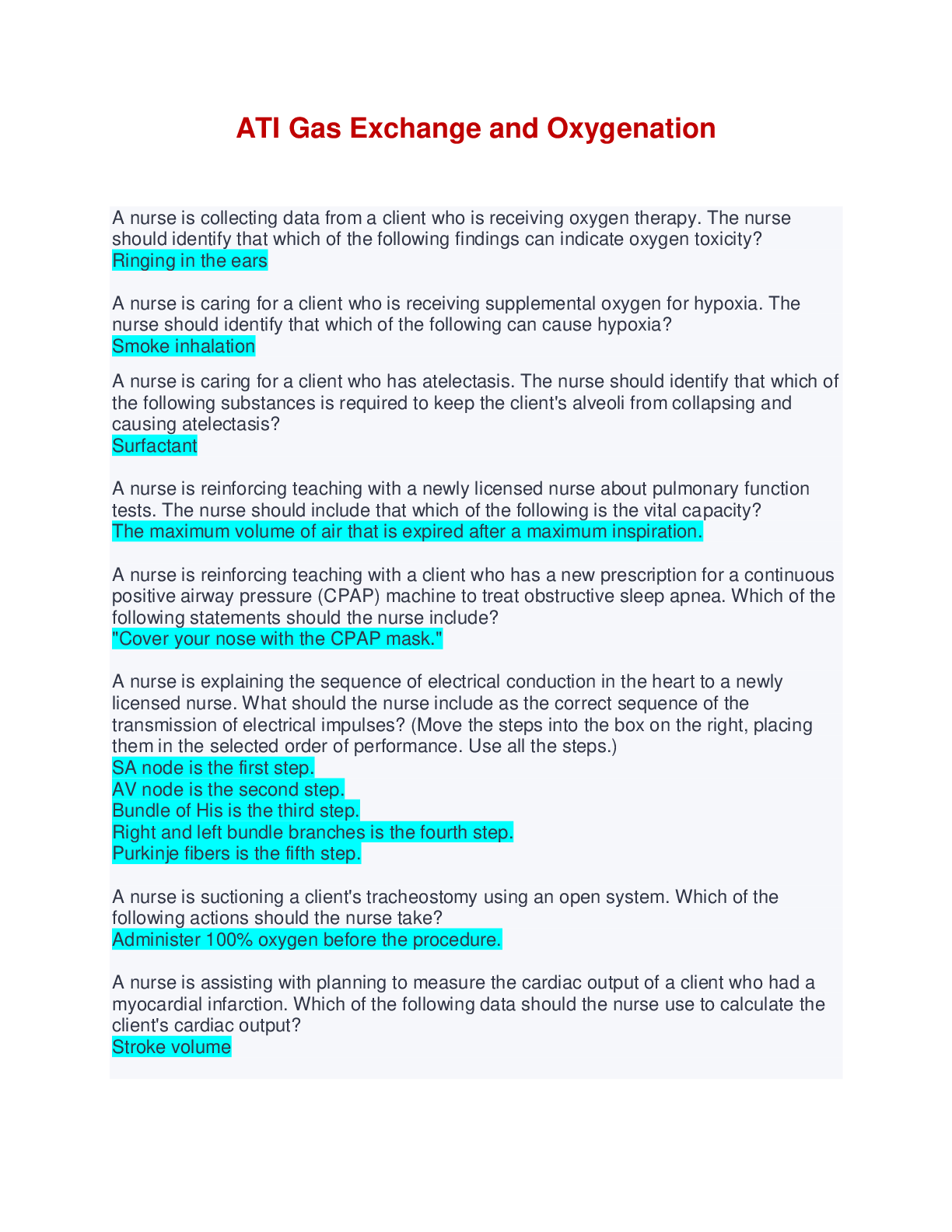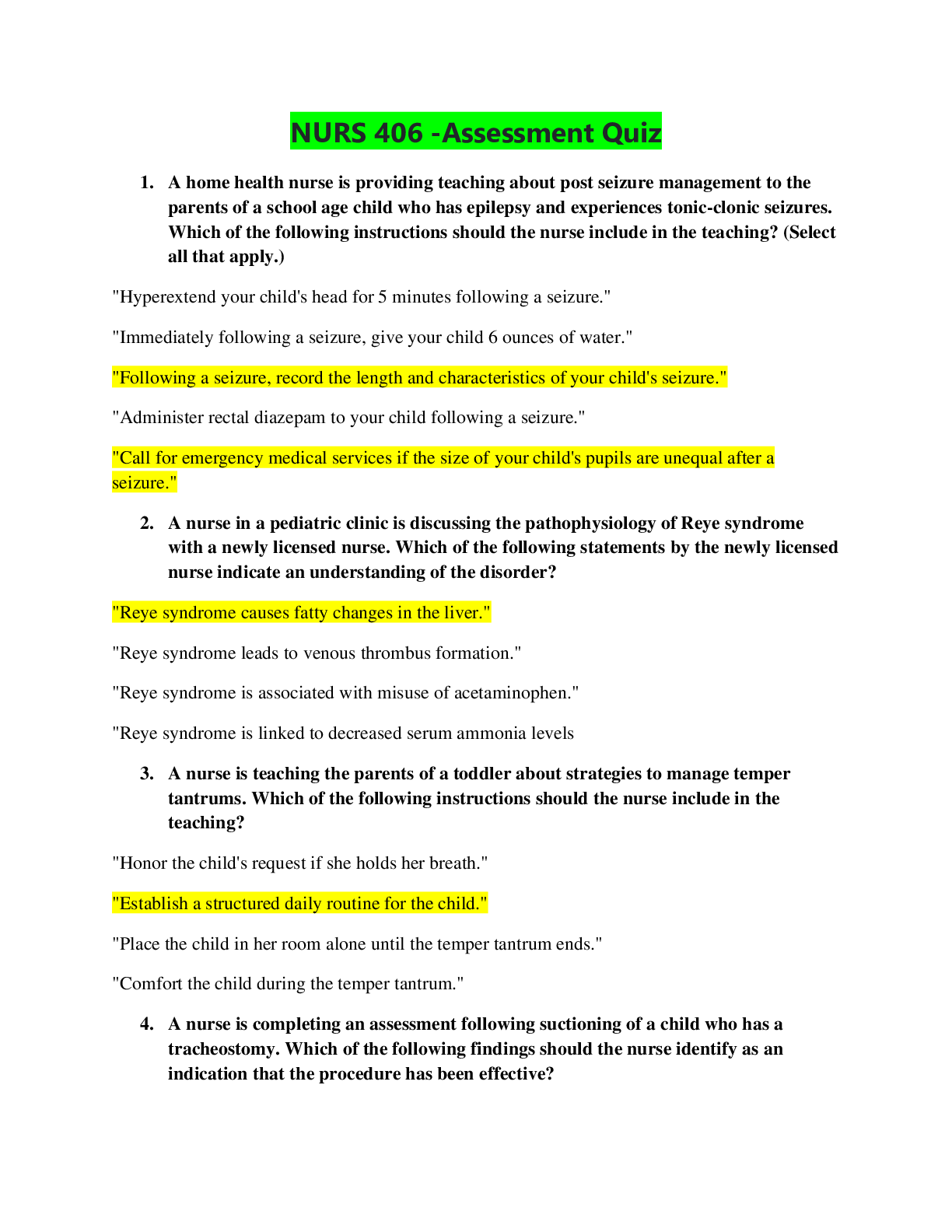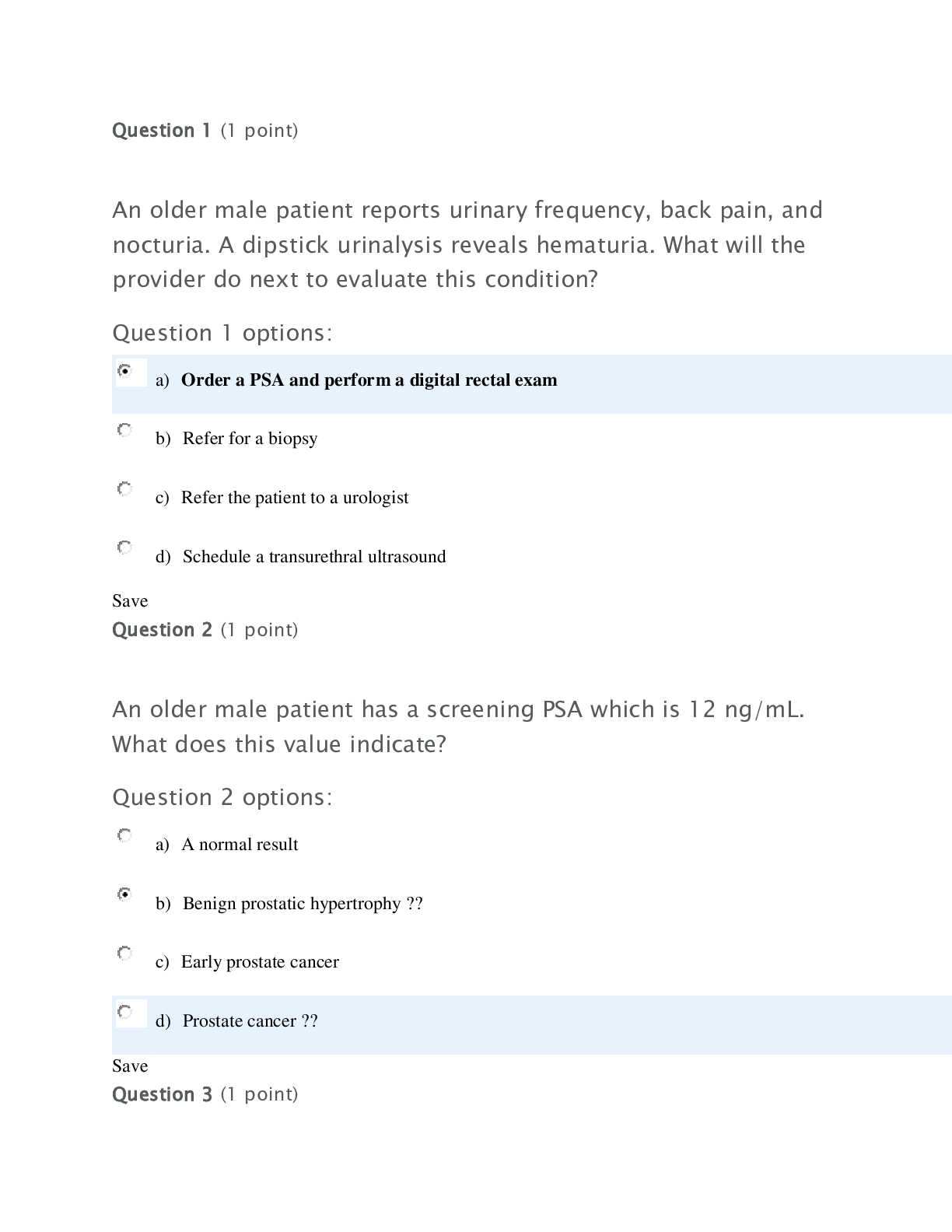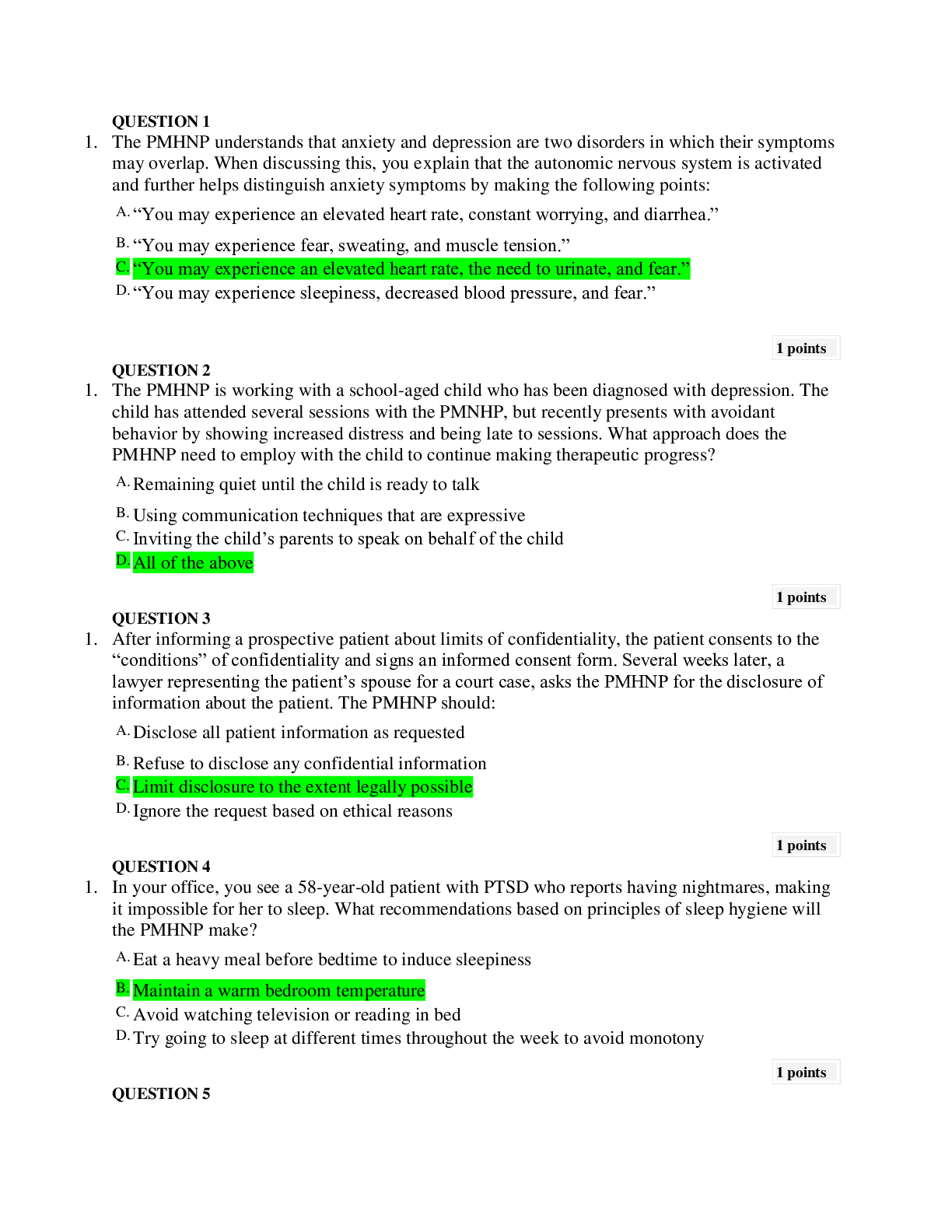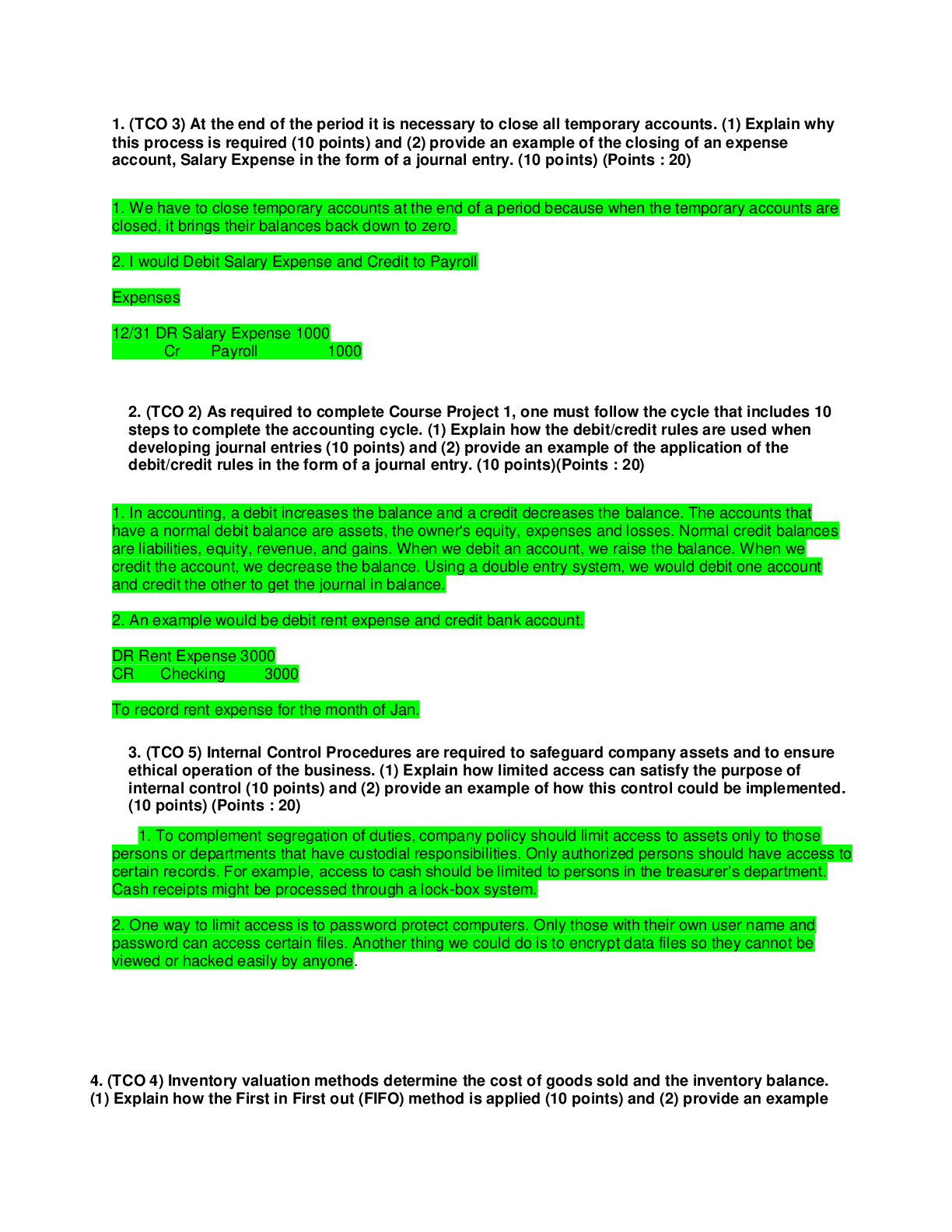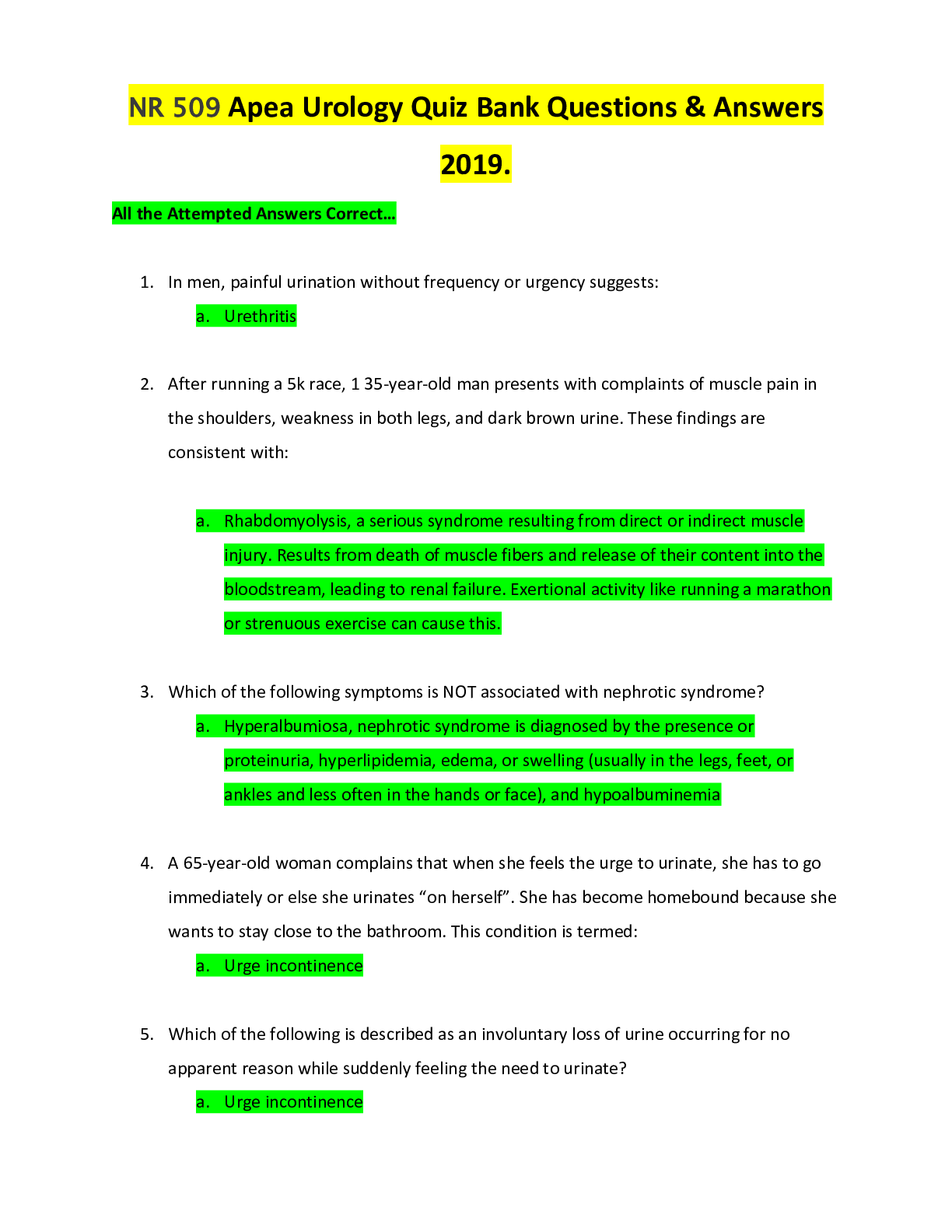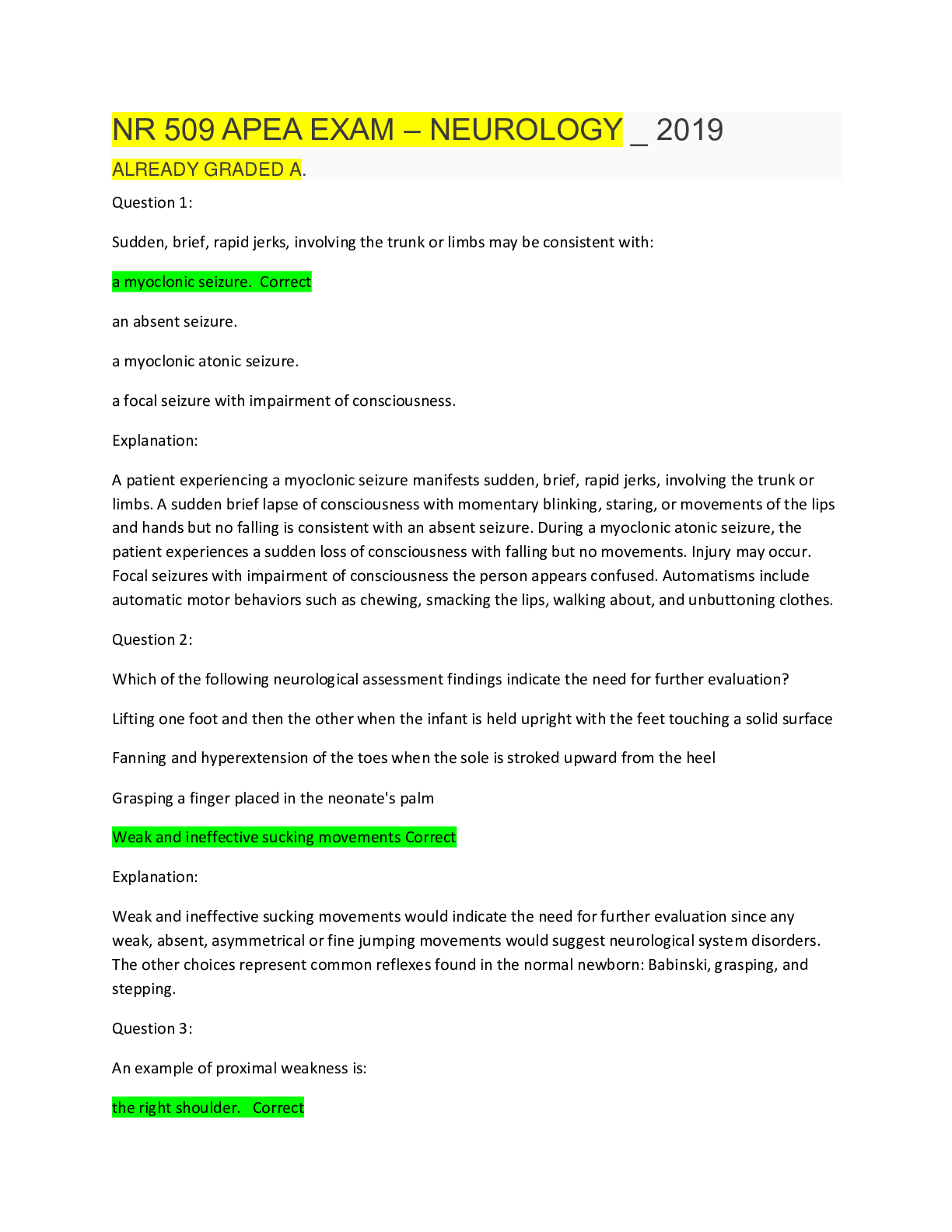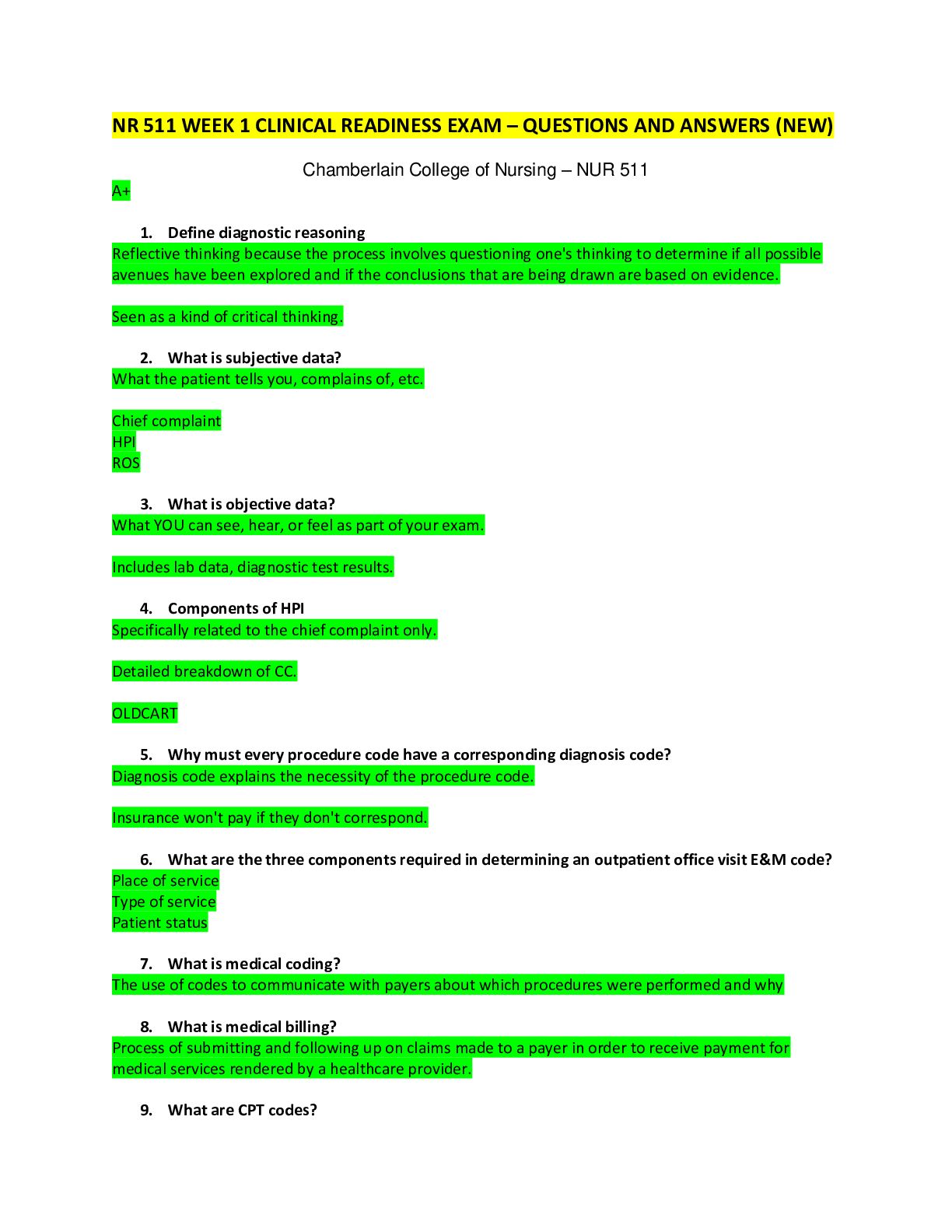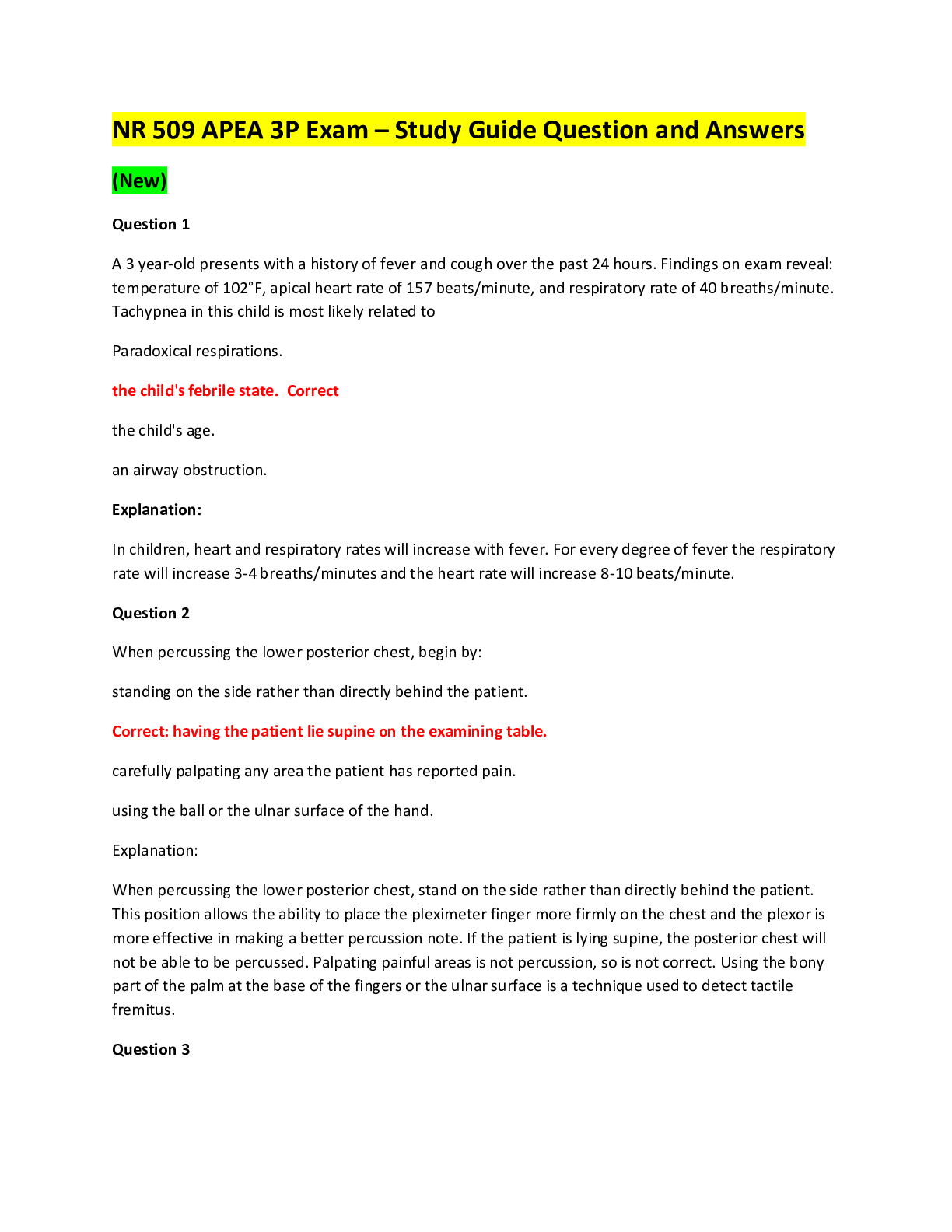*NURSING > EXAM > Chamberlain College of Nursing - ACCT 212 Final Exam Questions and Answers Rated A (All)
Chamberlain College of Nursing - ACCT 212 Final Exam Questions and Answers Rated A
Document Content and Description Below
ACCT 212 Final Exam Question 1.1. (TCO 3) Closing temporary accounts is necessary at the end of the accounting period. (1) Explain the closing process, include each set of entries required (15 points... ) & (2) provide an example of closing the Dividend account in the form of a journal entry. (10 points). (Points : 25) Closing entries are journal entries used to empty temporary accounts at the end of a reporting period & transfer their balances into permanent accounts. The use of closing entries resets the temporary accounts to begin accumulating new transactions in the next period. Otherwise, the balances in these accounts would be incorrectly included in the totals for the following reporting period. The basic sequence is as follows: 1. Debit all revenues account & credit the income summary account, thereby clearing out the balances in revenue account. 2. Credit all expenses account, & debit the income summary account, thereby clearing out all the balances in expense account. 3. Close the income summary account to the retained earnings account. If there was a profit in the period, then this entry is a debit to that income summary account & a credit to the retained earnings account. If there was a loss in the period, then this entry is a credit to the income summary account & debit to the retained earnings account. The net result of these activities is to move the net profit or loss for the period into the retained earning account, which appears in the stockholder's equity section of the balance sheet. Since the income summary account is only a transitional account, it is also acceptable to close directly to the retained earnings account & bypass the income summary account entirely. Journal entry for closing dividend: Retained Earnings Account Debit To Dividends Account Credit 2. (TCO 2) As required to complete Course Project 1, one must follow the cycle that includes 10 steps to complete the accounting cycle. (1) Explain how information from the journal entries get into the ledger accounts (15 points) & (2) provide an example of information that would be transferred. (10 points) (Points : 25) The journal entries recorded during the first step provide information about which accounts are to be debited & which to be credited & also the size of the debit or credit. The debit & credit values of journal entries are transferred to ledger accounts one by one in such a way that debit amount of a journal entry is transferred to the debit side of the relevant ledger account & the credit amount is transferred to the credit side of the relevant ledger account. After posting all the journal entries, the balance of each account is calculated. The balance of an asset, expense, contra-liability & contra-equity account is calculated by subtracting the sum of its credit side from the sum of its debit side. The balance of a liability, equity & contra-asset account is calculated the opposite way by subtracting the sum of its debit side from the sum of its credit side. 3. (TCO 4) Thomas Manufacturing had 4 units of their product in inventory at $250 per unit to start the month. During the month, they purchased an additional 7 units at $250 per unit & another 12 units at $275 per unit. Also, at the end of the month, they sold 12 units & ended the month at 8 units. Calculate their ending inventory & cost of goods sold using one of the following: LIFO, FIFO or Average Cost methods. Show all computations.(Points : 24) LIFO METHOD When using this method the inventory purchased recently is sold first. Sold goods = 12 units Given units are sold from $275 lot purchased at last. Cost of goods sold = $275 * 12 = $3,300 Ending inventory units = 8units Of these, 4 units will be taken to be beginning inventory & balance 4 units will be tabulated as from $250 lot first purchased. Ending inventory = $250 * 8 = $2,000 4. (TCO 4) A retailer needs to determine the cost of the shoes the company purchased in order to determine the inventory value to report on its balance sheet in a particular period. (1) Discuss the steps involved in determining the cost of shoes inventory as reported on the company’s balance sheet (15 points), & (2) use an example to show the impact of purchase discounts & allowances received by the company on the cost of shoes inventory (10 points). (Points : 25) Steps involved in determining the Cost of Shoes inventory: 1. Cost of purchase: Cost of purchase of shoes is the major cost in shoe inventory valuation, this purchase cost includes (a) Duties & taxes paid (b) Inward Freight paid (c) Other expenditure directly attributable to the acquisition of inventory i.e. any commission paid to middle man to acquire the inventory 2. Other costs: Cost incurred in bringing the shoe inventory to its present location & condition i.e. unloading of shoes, local transport paid, & arranging the shoes in the showroom. Expenditure, rent, lighting etc. should not include in the cost of inventory i.e. Administrative, Selling & distribution overheads should not be included in the cost of inventory. Trade Discounts: , The retailer receives any trade discounts, Rebates, Duties & taxes recoverable from taxing authorities & other similar benefits suppose availed by the retailer should be deducted from the purchase price. (2) Example: Suppose a Retailer Purchased 1,000 shoes @ $ 10 per shoe, Trade discount allowed @ 5% on the purchase price, Freight inward $ 100, Other taxes $ 50, Duty draw back $ 10.What is the cost of inventory? Solution: Calculation of Cost of inventory & effect of Discounts & allowance Purchase of price of 1000 shoes @ $ per shoe $ 10,000 Less: Trade discounts @ 5% ($ 10,000 x 5%) $ 500 Invoice price $ 9,500 Add: Freight incurred $ 100 Add: Taxes Paid $ 50 $ 9,650 Less: Duty draw back (return of tax) $ 10 Cost of shoe inventory $ 9,640 Note: Due to Discounts & allowances allowed by the supplier, the cost of inventory is to be decreased. 5. (TCO 1) To evaluate the financial operations & health of a business, ratio anaylysis is used. 1) What do profitability ratios indicate about the company? (10 points) 2) Please provide 2 examples of profitability ratios & the related formula & indicate how they can be used in the decision making process. (15 points) (Points : 25) In general, profitability ratios measure the efficiency with which your company turns business activity into profits. Profit margins assess your ability to turn revenue into profits. Return on assets measures your ability to use assets to produce net income. Examples of profitability ratios are: a. Return on assets=(Net income/Total assets) Return on assets measures how effectively a company is able to produce profits from its assets & thus helps in decision making as the managers can interpret the amount of profits it will be able to generate from the assets of the company. b. Return on equity=Net income/shareholders equity It measures how much can a company can make for each dollar amount invested by investors & thus helps to take decisions as to how money should be invested to maximize returns. Essay questions 1. (TCO 6) BagODonuts Company bought a used delivery truck on January 1, 2010, for $19,200. The van was expected to remain in service 4 years (30,000 miles). BagODonuts’ accountant estimated that the truck’s residual value would be $2,400 at the end of its useful life. The truck traveled 8,000 miles the first year, 8,500 miles the second year, 5,500 miles the third year, & 8,000 miles in the fourth year. 1. Calculate depreciation expense for the truck for each year (2010-2013) using the: a. Straight-line method. b. Double-declining balance method. c. Units of Production method. (For units-of-production & double-declining balance, round to the nearest two decimals after each step of the calculation.) 2. Which method best tracks the wear & tear on the van? 3. Which method would BagODonuts prefer to use for income tax purposes? Explain in detail why BagODonuts prefers this method. (Points : 25) Answer 1a. Straight-line Method ($19200 - $2400)/ 4 = $5600 1b. Double-declining method: 1st = $9,600 2nd= $4,800 3rd = $2,400 1c. Depreciation Cost = Original Cost - Salavage Value = $16800 Depreciation per Unit = $16800 / 30000 miles = 0.56 Yr 1 - .56 x 8000 = 4480, Yr 2 .56 x 8500 = 4760, Yr 3 .56 x 5500 = 3080, Yr 4 .56 x 8000 = 4480 2. Which best tracks the wear & tear on the van? Units of production method 1. Which method BagODonuts prefer to use for income tax purposes? Explain why BagODonuts chose this one: Double Declining Balance would be chosen because it provides the greatest reduction in taxable income. This will free up more money to grow the business & invest in more assets. 2. (TCO 7) ABC Inc. was incorporated on 1/15/12. Their corporate charter authorized the following capital stock: Preferred Stock: 7%, par value $100 per share, 100,000 shares. Common Stock: $1 par value, 500,000 shares. The following transactions occurred during the year: 1/19/12 – Issued 100,000 shares of common stock for $17 cash per share. 1/31/12 – Issued 3,000 shares of preferred stock for $115 cash per share. 11/1/12 – Repurchased 30,000 shares of common stock for $22 cash per share. 12/1/12 – Declared & paid a total dividend of $95,000. Required: 1. Prepare the journal entry for each transaction listed above. 2. In your own words, explain the main differences between common & preferred stock. (Points : 25) 2. (TCO 7) ABC Inc. was incorporated on 1/15/12. Their corporate charter authorized the following capital stock: Preferred Stock: 7%, par value $100 per share, 100,000 shares. Common Stock: $1 par value, 500,000 shares. The following transactions occurred during the year: 1/19/12 – Issued 100,000 shares of common stock for $17 cash per share. 1/31/12 – Issued 3,000 shares of preferred stock for $115 cash per share. 11/1/12 – Repurchased 30,000 shares of common stock for $22 cash per share. 12/1/12 – Declared & paid a total dividend of $95,000. Required: 1. Prepare the journal entry for each transaction listed above. 2. In your own words, explain the main differences between common & preferred stock. (Points : 25) Answer ABC Company 1/19 Cash 1,700,000.00 Common Stock 100,000.00 Capital in excess of par 1,600,000.00 (Issued Common Stock) 1/31 Cash 345,000.00 Preferred Stock 300,000.00 Capital in excess of par 45,000.00 (Issued preferred shares) 11/1 Stock Repurchase 660,000.00 Cash 660,000.00 Reacquired common shares 12/1 Dividends 95,000.00 Cash 95,000.00 Declared & paid cash dividends Preferred stock is a type of capital stock which has specific dividends that is distributed first before common stockholders can receive any dividends declared & paid. In the event of liquidation, preferred stockholders are prioritized first before common stockholders can receive any remaining assets of the company. Common stock enjoys voting rights which preferred stock don't have. Common stock receives dividends only after the preferred dividends are satisfied first. & if the business is liquidated, it receives any remaining assets only after creditors & preferred shareholders have been paid or satisfied. 3. (TCO 5) Internal Control Procedures are in place to protect the assets of every business as mentioned in the textbook & our discussions. Of the seven internal control procedures, list five of these controls & describe how each procedure is implemented (Points : 25) Answer Smart Hiring Practices & Separation of Duties, Comparisons & Compliance Monitoring, Adequate Records, Limited Access, & Proper Approvals are 5 internal controls. With Smart hiring practice each person in the information chain is important. The chain should start with hiring. Background checks should be conducted on job applicants. smart management separates three key duties: asset h& ling, record keeping, & transaction approval so there is no opportunity for 1 person to commit fraud. Comparisons & Compliance Monitoring ensures that no person or department should be able to completely process a transaction from beginning to end without being cross-checked by another person or department. This will reduce errors & establish a chain of comm& . Adequate Records provide the details of business transactions. The general rule is that all major groups of transactions should be supported by either hard copy documents or electronic records. This will create a traceable paper trail. Limited Access - complements segregation of duties, company policy should limit access to assets only to those persons or departments that have custodial responsibilities. For example, access to cash should be limited to persons in the treasurer’s department. Proper Approvals ensures no transaction should be processed without management’s general or specific approval. The bigger the transaction, the more specific approval it should have. Checks & balances will keep mistakes & fraud to minimum. 4. (TCO 2) Below are the accounts of Super Pool Service, Inc. The accounts have normal balances on June 30, 2012. The accounts are listed in no particular order. Account Balance Common stock $5,100 Accounts payable $4,400 Service revenue $17,100 L& $28,800 Note payable $9,500 Cash $5,200 Dividends $6,100 Utilities expense $2,100 Accounts receivable $10,600 Delivery expense $700 Retained earnings $25,600 Salary expense $8,200 Prepare the company’s trial balance as of June 30, 2012, listing accounts in proper sequence, as illustrated in the chapter. For example, Accounts Receivable comes before L& . List the expense with the largest balance first, the expense with the next largest balance second, & so on. (Points : 25) Answer Super Pool Service, Inc. Trial balance 30-Jun-12 Debit Credit Cash DR $5,200 Accounts receivable DR $10,600 L& DR $28,800 Accounts payable CR $4,400 Note payable CR $9,500 Common stock CR $5,100 Retained earnings CR $25,600 Dividends DR $6,100 Service revenue CR $17,100 Salary expense DR $8,200 Utilities expense DR $2,100 Delivery expense DR $700 Total $61,700 $61,700 5. (TCO 4) Linda’s Lampshades started business on Jan. 1, 2001. They had the following inventory transactions: Journals - Jan. 2001 Purchases Supplier Date Received Quantity Unit Cost Amount Donna 01/10/01 110 12.00 1320.00 Thomas 01/15/01 160 14.00 2240.00 Cindy 01/18/01 150 15.00 2250.00 Sales Customer Date shipped Quantity Sel. Price Amount Norilene 01/16/01 200 25.00 5000.00 1. Calculate the ending inventory, using the perpetual inventory method: A. Using FIFO B. Using LIFO C. Using Average Cost 2. Prepare the following statement Using FIFO LIFO Average Cost Sales Cost of Sales Gross Profit (Points : 25) 6. (TCO4) Linda’s Lampshades started business on Jan. 1, 2001. They had the following inventory transactions: Journals - Jan. 2001 Purchases Supplier Date Received Quantity Unit Cost Amount Donna 01/10/01 110 12.00 1320.00 Thomas 01/15/01 160 14.00 2240.00 Cindy 01/18/01 150 15.00 2250.00 Sales Customer Date shipped Quantity Sel. Price Amount Norilene 01/16/01 200 25.00 5000.00 1. Calculate the ending inventory, using the perpetual inventory method: A. Using FIFO B. Using LIFO C. Using Average Cost 2. Prepare the following statement Using FIFO LIFO Average Cost Sales Cost of Sales Gross Profit (Points : 25) Answer LINDA'S LAMPSHADES 1) Ending inventory: a. FIFO ending inventories = 2250 + (70 x 14) = 2250 + 980 = $ 3,230 b. LIFO ending inventories = 2250 + (70 x 12) = 2250 + 840 = $ 3,090 c. Average Cost = (1320 + 2240 + 2250) / (110 + 160 + 150) = 5810 / 420 = 13.83 Average Cost = 13.83 x (420 - 200) = 13.83 x 220 = $ 3,042.60 2) Income Statement FIFO LIFO Average Cost Sales 5,000.00 5,000.00 5,000.00 Cost of Sales 2,580.00 2,720.00 2,767.00 Gross Profit 2,420.00 2,280.00 2,233.00 [Show More]
Last updated: 1 year ago
Preview 1 out of 10 pages
Instant download
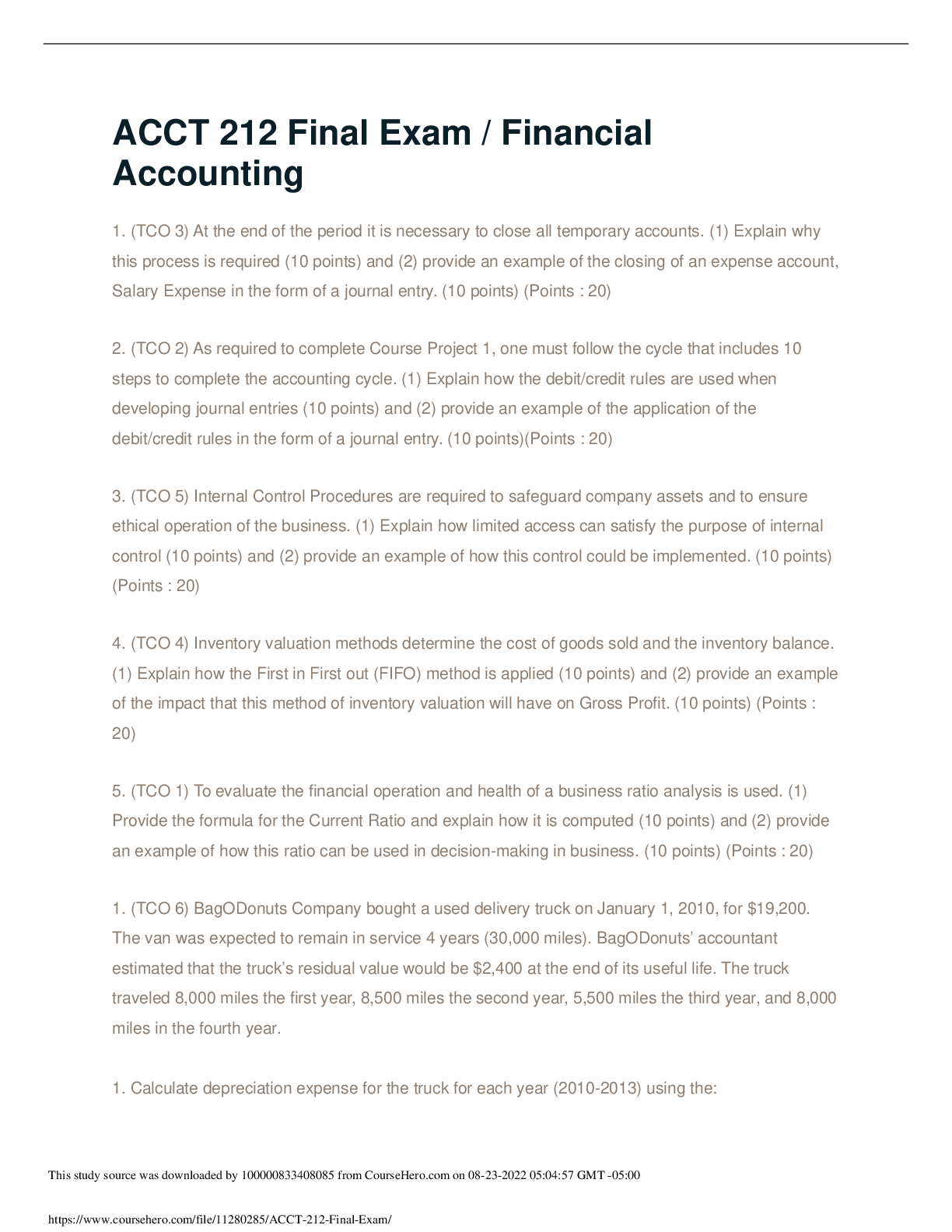
Buy this document to get the full access instantly
Instant Download Access after purchase
Add to cartInstant download
Reviews( 0 )
Document information
Connected school, study & course
About the document
Uploaded On
Oct 31, 2020
Number of pages
10
Written in
Additional information
This document has been written for:
Uploaded
Oct 31, 2020
Downloads
0
Views
118


